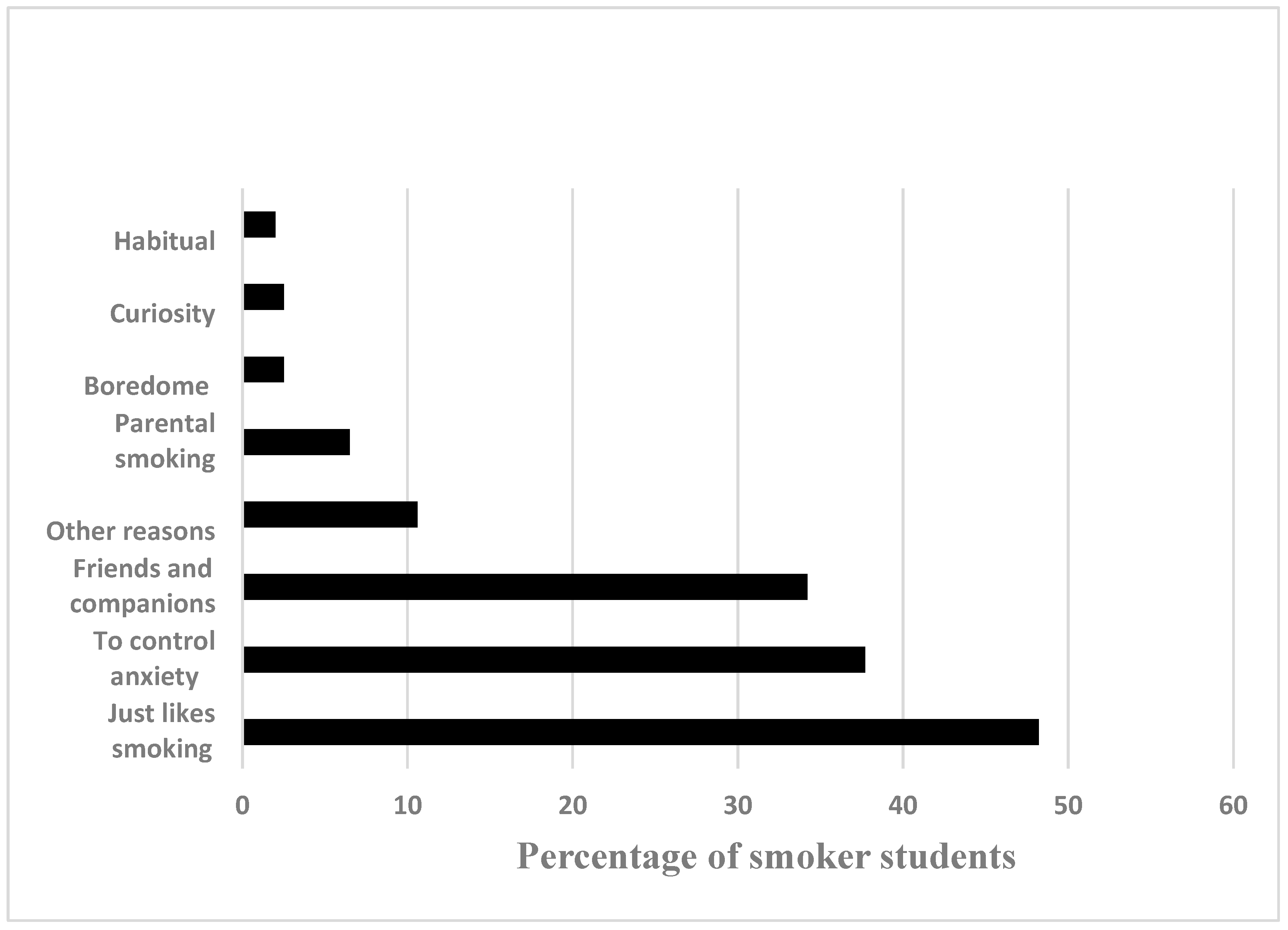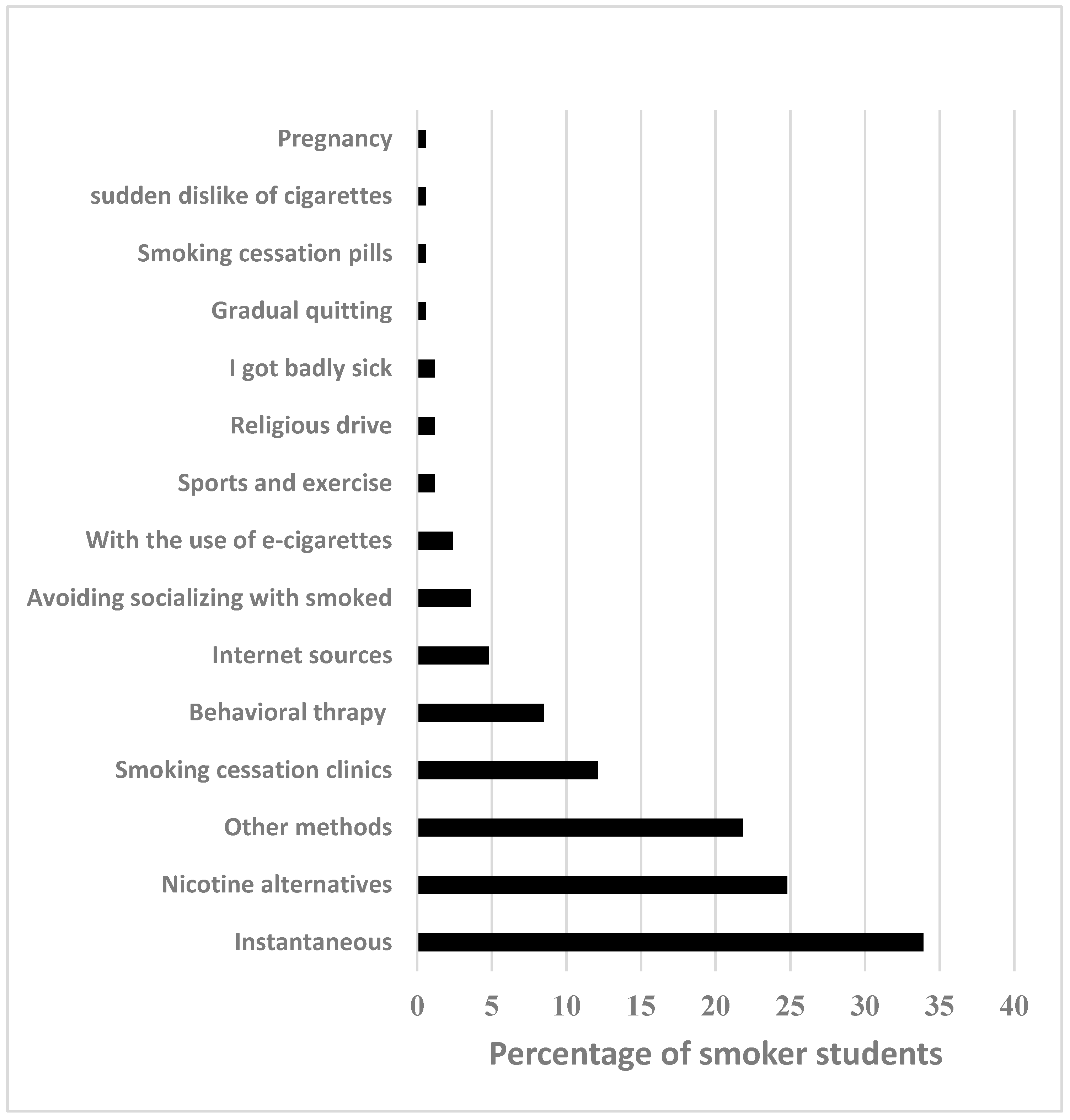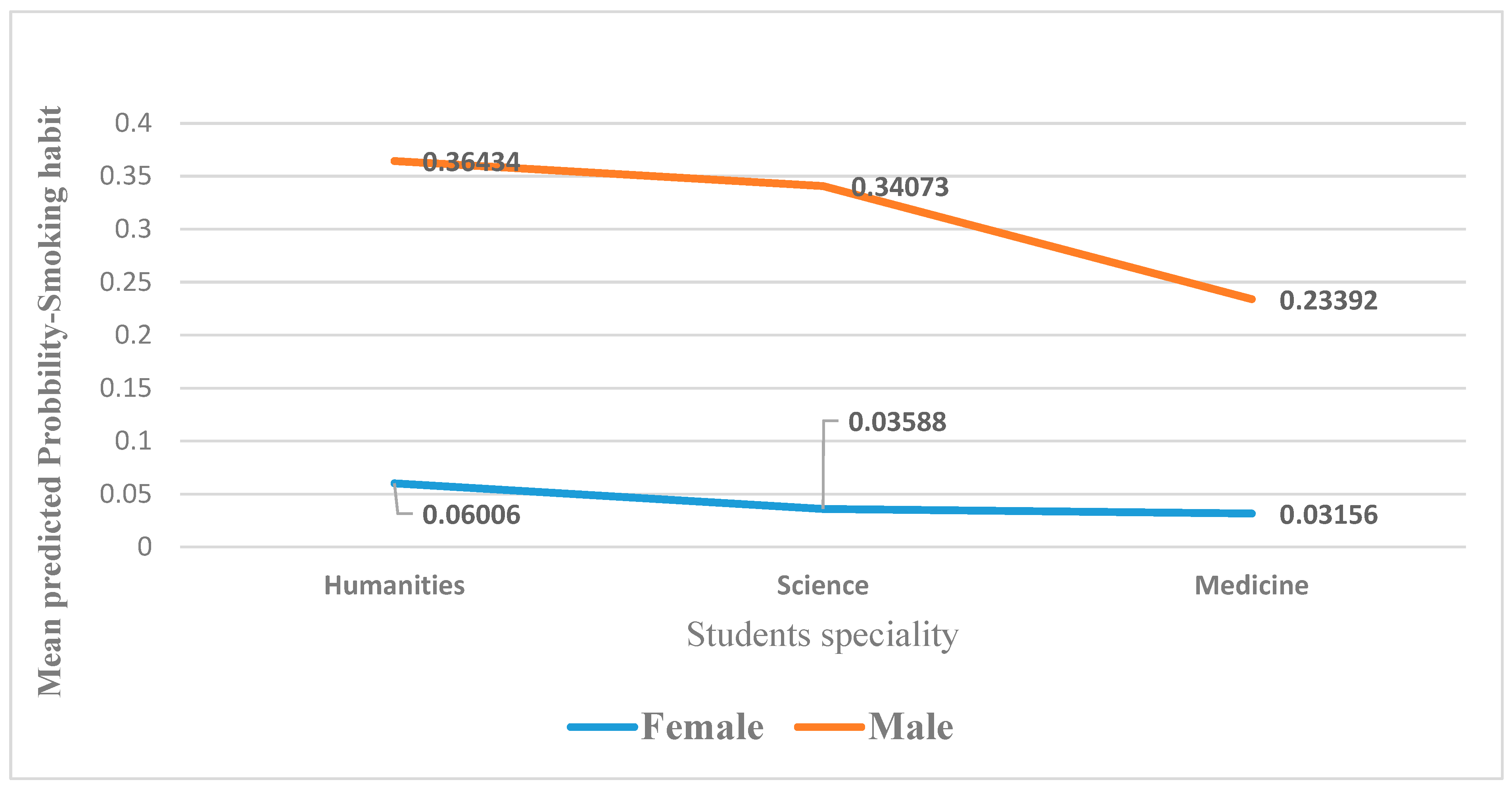Smoking Habits among College Students at a Public University in Riyadh, Saudi Arabia
Abstract
:1. Introduction
2. Materials and Methods
2.1. Study Design
2.2. Participants and Sampling
2.3. Study Measurements
2.4. Statistical Data Analysis
3. Results
4. Discussion
5. Conclusions
Author Contributions
Funding
Institutional Review Board Statement
Informed Consent Statement
Data Availability Statement
Conflicts of Interest
References
- Mackay, J.; Eriksen, M.; Shafey, O. The Tobacco Atlas, 2nd ed.; American Cancer Society: Atlanta, GA, USA, 2006; pp. 1106–1107. [Google Scholar]
- WHO Report on the Global Tobacco Epidemic, 2011: Warning about Tobacco Dangers. Available online: https://apps.who.int/iris/handle/10665/44616 (accessed on 28 April 2022).
- Alasqah, I.; Mahmud, I.; East, L.; Usher, K. A systematic review of the prevalence and risk factors of smoking among Saudi adolescents. Saudi Med. J. 2019, 40, 867–878. [Google Scholar] [CrossRef] [PubMed]
- Althobaiti, N.K.; Mahfouz, M.E.M. Prevalence of Electronic Cigarette Use in Saudi Arabia. Cureus 2022, 14, e25731. [Google Scholar] [CrossRef] [PubMed]
- Alotaibi, S.A.; Alsuliman, M.; Durgampudi, P.K. Smoking tobacco prevalence among college students in the Kingdom of Saudi Arabia: Systematic review and meta-analysis. Tob. Induc. Dis. 2019, 17, 35. [Google Scholar] [CrossRef] [PubMed]
- Alotaibi, S.A.; Durgampudi, P.K. Factors associated with tobacco smoking among Saudi college students: A systematic review. Tob. Prev. Cessat 2020, 6, 36. [Google Scholar] [CrossRef] [PubMed]
- Al-Mohamed, H.I.; Amin, T.T. Pattern and prevalence of smoking among students at King Faisal University, Al Hassa, Saudi Arabia. East. Mediterr. Health J. 2010, 16, 56–64. [Google Scholar] [CrossRef] [PubMed]
- Jiang, G.; Aldamer, S.; Bendania, A. Smoking behaviour among male students in a Saudi University. East. Mediterr. Health J. 2018, 24, 411–418. [Google Scholar] [CrossRef] [PubMed]
- Bassiony, M.M. Smoking in Saudi Arabia. Saudi Med. J. 2009, 30, 876–881. [Google Scholar] [PubMed]
- ANTI-SMOKING LAW: Implementing Regulations Version 3 2019; Issued by Saudi Royal Decree No. (M/56) Dated 28/07/1436 H Corresponding to 17 May 2015. Available online: https://www.moh.gov.sa/en/Ministry/Rules/Documents/Anti-Tobacco-Executive-Regulations.pdf (accessed on 10 September 2022).
- Structurae. References|Asking Questions, Analysing Answers: Relative Importance Revisited. Available online: https://structurae.net/en/literature/journal-article/asking-questions-analysing-answers-relative-importance-revisited/references (accessed on 28 August 2022).
- Qanash, S.; Alemam, S.; Mahdi, E.; Softah, J.; Touman, A.A.; Alsulami, A. Electronic cigarettes among health science students in Saudi Arabia. Ann. Thorac. Med. 2019, 14, 56–62. [Google Scholar] [CrossRef] [PubMed]
- Alshanberi, A.M.; Baljoon, T.; Bokhari, A.; Alarif, S.; Madani, A.; Hafiz, H.; Altayyar, A.A.; Abo-Ali, E. The prevalence of E-cigarette uses among medical students at Umm Al-Qura University; a cross-sectional study. J. Fam. Med. Prim. Care. 2021, 10, 3429–3435. [Google Scholar]
- Alqahtani, J. Knowledge, attitude and practice of tobacco smoking among health colleges’ students at Najran University, Saudi Arabia: A cross-sectional descriptive study. J. Health Spec. 2017, 5, 35. [Google Scholar] [CrossRef]
- Alzahrani, S.H. Levels and factors of knowledge about the related health risks of exposure to secondhand smoke among medical students: A cross-sectional study in Jeddah, Saudi Arabia. Tob. Induc. Dis. 2020, 18, 88. [Google Scholar] [CrossRef] [PubMed]
- Kasim, K.; Al-Zalabani, A.; Abd El-Moneim, E.; Amer, S. Beliefs and attitudes of male and female adolescents and the risk of smoking behavior. J. Postgrad. Med. 2016, 62, 80–85. [Google Scholar] [PubMed]
- Alwhaibi, A.; Wajid, S.; Alenezi, A.; Salami, Y.; Alhaydan, I.; Samreen, S.; Alhossan, A.; Al-Arifi, M.N. Prevalence of Smoking and Beliefs and Attitude Toward Smoking Habit and Smoking Cessation Methods Among Pharmacy Students: A Cross-Sectional Study in Saudi Arabia. Front. Public Health 2022, 10, 816101. [Google Scholar] [CrossRef] [PubMed]
- Merdad, L.A.; Al-Zahrani, M.S.; Farsi, J.M. Smoking habits among Saudi female university students: Prevalence, influencing factors, and risk awareness. Ann. Saudi Med. 2007, 27, 366–369. [Google Scholar] [CrossRef] [PubMed]
- Alhabib, K.F.; Batais, M.A.; Almigbal, T.H.; Alshamiri, M.Q.; Altaradi, H.; Rangarajan, S.; Yusuf, S. Demographic, behavioral, and cardiovascular disease risk factors in the Saudi population: Results from the Prospective Urban Rural Epidemiology study (PURE-Saudi). BMC Public Health 2020, 20, 1213. [Google Scholar] [CrossRef] [PubMed]
- Al-Nimr, Y.M.; Farhat, G.; Alwadey, A. Factors Affecting Smoking Initiation and Cessation Among Saudi Women Attending Smoking Cessation Clinics. Sultan Qaboos Univ. Med. J. 2020, 20, e95–e99. [Google Scholar] [CrossRef] [PubMed]
- Tobaiqy, M.; Thomas, D.; MacLure, A.; Stewart, D.; MacLure, K. Staff and student experiences and attitudes towards smoking and smoking cessation, University of Jeddah, Saudi Arabia. Tob. Prev. Cessat. 2021, 7, 73. [Google Scholar] [CrossRef] [PubMed]
- Schar, E.H.; Gutierrez, K.K. Smoking Cessation Media Campaigns from around the World: Recommendations from Lessons Learned; World Health Organization, Regional Office for Europe: Copenhagen, Denmark, 2001; pp. 1–35. Available online: https://www.euro.who.int/__data/assets/pdf_file/0017/68111/E80056.pdf (accessed on 14 July 2022).



| Frequency | Percentage (%) | |
|---|---|---|
| Sex | ||
| Female | 306 | 34.2 |
| Male | 589 | 65.8 |
| Age group—years | ||
| 18–22 years | 562 | 62.8 |
| 23–26 years | 272 | 30.4 |
| >26 | 61 | 6.8 |
| Nationality | ||
| Non-Saudi | 33 | 3.7 |
| Saudi | 862 | 96.3 |
| College | ||
| Humanities science | 586 | 63.5 |
| Science streams college (engineering + computer) | 153 | 17.1 |
| Medicine | 174 | 19.4 |
| Education year | ||
| Junior (entry to 3rd year) | 368 | 41.1 |
| Intermediate (4th–5th year) | 256 | 28.6 |
| Senior (6th year or higher) | 271 | 30.3 |
| Frequency | Percentage (%) | |
|---|---|---|
| In general, are you a smoker? Or do you smoke any kind of tobacco? | ||
| Never used/tried | 684 | 76.4 |
| Former smoker | 47 | 5.3 |
| Current smoker | 164 | 18.3 |
| Do you use e-Cigarettes? | ||
| Never used/tried | 835 | 93.3 |
| Former user | 15 | 1.7 |
| Currently smoking e-Cigarettes | 45 | 5 |
| Do you use Shisha (hookah) | ||
| Never used/tried | 745 | 83.2 |
| Former Shisha smoker | 44 | 4.9 |
| Current shisha Smoker | 106 | 11.8 |
| Do you have a family member who is a smoker? | ||
| No | 389 | 43.5 |
| Unsure | 31 | 3.5 |
| Yes | 475 | 53.1 |
| Frequency | Percentage (%) | |
|---|---|---|
| For how many years did you smoke? | ||
| 1–5 years | 98 | 48.4 |
| 6–10 years | 60 | 26.4 |
| 11–16 years | 20 | 9.5 |
| >16 | 33 | 15.6 |
| How many cigarettes do you smoke per day? | ||
| Not sure/Not answered | 6 | 2.8 |
| ≤ten cigarettes per day | 68 | 32.2 |
| 11–20 Cigarettes per day | 104 | 49.3 |
| 21–30 Cigarettes per day | 22 | 10.4 |
| >30 cigarettes per day | 11 | 5.2 |
| Describe your current smoking situation | ||
| Former smoker | 47 | 22.3 |
| Smoked at one time or another | 28 | 13.3 |
| I smoke Irregularly | 40 | 19 |
| I am trying to quit cigarettes | 51 | 24.2 |
| I currently smoke regularly | 45 | 21.3 |
| When do you like to smoke/What are the times you want to smoke, n = 203 | ||
| I smoke most of the day times | 112 | 55.2 |
| Other times | 11 | 5.4 |
| I like to smoke after meals/coffee | 97 | 47.8 |
| I smoke when I feel stressed/under pressure | 116 | 57.1 |
| I smoke when I meet friends who smoke too | 106 | 52.2 |
| Did you try to quit smoking? | ||
| I am a former smoker | 47 | 22.3 |
| No | 45 | 21.3 |
| Yes | 119 | 56.4 |
| For how long did your quit period last | ||
| Not sure/Not answered | 58 | 27.5 |
| A week or less | 41 | 19.4 |
| From more than a week to less than a month | 57 | 27 |
| 1–3 Months | 33 | 15.6 |
| 4–6 Months | 8 | 3.8 |
| 7–9 Months | 2 | 0.9 |
| 10–12 Months | 3 | 1.4 |
| >12 Months | 9 | 4.3 |
| How much Saudi riyal did you spend on buying cigarettes per week? | ||
| Less than 100 Saudi riyals | 56 | 26.5 |
| 100–200 Saudi riyals | 117 | 55.5 |
| 300–500 Saudi riyals | 25 | 11.8 |
| Greater than 500 Saudi riyals | 13 | 6.2 |
| Rate your enjoyment level of cigarettes smoking | ||
| I don’t enjoy when smoking at all | 31 | 14.7 |
| I feel a slight joy when I smoke cigarettes | 118 | 55.9 |
| I have a lot of fun when I smoke cigarettes | 62 | 29.4 |
| How old were you when you had your first cigarettes? | ||
| Can’t remember | 7 | 3.3 |
| Less than 11 years old | 18 | 8.5 |
| 11–15 years old | 68 | 32.2 |
| 16–19 years old | 87 | 41.2 |
| 20 years old or older | 31 | 14.7 |
| Whenever you were sick, did you still smoke? | ||
| No | 100 | 47.4 |
| Sometimes | 78 | 37 |
| Yes | 33 | 15.6 |
| While smoking, did you realize that smoking is harmful to your health? | ||
| No | 11 | 5.2 |
| Unsure/Do Not know | 8 | 3.8 |
| Yes | 192 | 91 |
| Adjusted Odds Ratio | 95% CI for OR | p-Value | ||
|---|---|---|---|---|
| Lower | Upper | |||
| Students’ Sex = Male | 7.325 | 3.982 | 13.476 | <0.001 |
| Student’s age | 1.329 | 0.915 | 1.929 | 0.135 |
| Students’ nationality | 2.468 | 0.696 | 8.744 | 0.162 |
| Stream = Medicine | 0.006 | |||
| Stream = Humanities | 2.252 | 1.325 | 3.830 | 0.003 |
| Stream = Science | 1.360 | 0.657 | 2.817 | 0.408 |
| Students’ education year | 1.113 | 0.847 | 1.462 | 0.441 |
| E-cigarette use = Never used/tried | 0.014 | |||
| E-cigarette use = Former | 2.526 | 0.681 | 9.361 | 0.166 |
| E-cigarette use = Current | 2.842 | 1.314 | 6.146 | 0.008 |
| Shisha use = Never used/tried | <0.001 | |||
| Shisha use = Former | 16.892 | 6.886 | 41.440 | <0.001 |
| Shisha use = Current | 6.673 | 3.993 | 11.150 | <0.001 |
| Smoker family members = No | <0.001 | |||
| Smoker family members = unsure | 2.175 | 0.749 | 6.316 | 0.153 |
| Smoker family members = Yes | 2.628 | 1.729 | 3.994 | <0.001 |
| Constant | 0.002 | <0.001 | ||
Publisher’s Note: MDPI stays neutral with regard to jurisdictional claims in published maps and institutional affiliations. |
© 2022 by the authors. Licensee MDPI, Basel, Switzerland. This article is an open access article distributed under the terms and conditions of the Creative Commons Attribution (CC BY) license (https://creativecommons.org/licenses/by/4.0/).
Share and Cite
Bin Abdulrahman, K.A.; Alghamdi, H.A.; Alfaleh, R.S.; Albishri, W.S.; Almuslamani, W.B.; Alshakrah, A.M.; Alsuwailem, H.M.; Alkhelaiwi, S.A. Smoking Habits among College Students at a Public University in Riyadh, Saudi Arabia. Int. J. Environ. Res. Public Health 2022, 19, 11557. https://doi.org/10.3390/ijerph191811557
Bin Abdulrahman KA, Alghamdi HA, Alfaleh RS, Albishri WS, Almuslamani WB, Alshakrah AM, Alsuwailem HM, Alkhelaiwi SA. Smoking Habits among College Students at a Public University in Riyadh, Saudi Arabia. International Journal of Environmental Research and Public Health. 2022; 19(18):11557. https://doi.org/10.3390/ijerph191811557
Chicago/Turabian StyleBin Abdulrahman, Khalid A., Hatem Ali Alghamdi, Rayan Sulaiman Alfaleh, Waleed Saleh Albishri, Walid Bandar Almuslamani, Abdulelah Murdhi Alshakrah, Hamad Mohammed Alsuwailem, and Sultan Ali Alkhelaiwi. 2022. "Smoking Habits among College Students at a Public University in Riyadh, Saudi Arabia" International Journal of Environmental Research and Public Health 19, no. 18: 11557. https://doi.org/10.3390/ijerph191811557
APA StyleBin Abdulrahman, K. A., Alghamdi, H. A., Alfaleh, R. S., Albishri, W. S., Almuslamani, W. B., Alshakrah, A. M., Alsuwailem, H. M., & Alkhelaiwi, S. A. (2022). Smoking Habits among College Students at a Public University in Riyadh, Saudi Arabia. International Journal of Environmental Research and Public Health, 19(18), 11557. https://doi.org/10.3390/ijerph191811557






